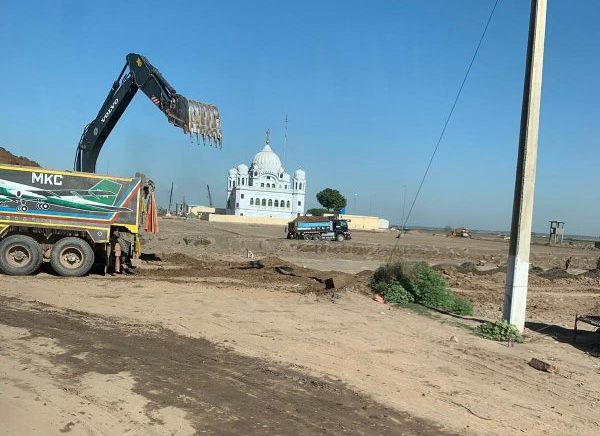Kartarpur Sahib: A Pilgrimage Corridor to Unite

By Bhupinder Singh
Houston: The concept of Kartarpur city was conceived by Guru Nanak Dev Ji, and was also given the concrete shape by Guru Ji himself in 1522 AD when he moved and settled there. He was 52 years old when he settled there and lived last 18 years of his life there with his family.
In fact, it is longest stint of Guru Ji’s life in one place. This serene, congregational cum egalitarian commune, became a magnet attracting adherents of different faiths to it, who followed Guru Ji and made it their home.
Unfortunately, during the turmoil of drawing of the partition lines of the sub-continent by the Radcliffe commission, this idyllic commune became a traumatic victim. Although, the district of Gurdaspur was awarded to India, but one Tehshil Shakargarh out of the four of the district along with Kartarpur was awarded to Pakistan.
With most of Sikh population migrating to India, this serene town found itself almost abandoned. Since the partition in 1947, the Gurdwara remained in disuse and it was only reopened in 1999 to coincide with Indian PM Vajpayee’s visit to Pakistan. Eighteen years after the reopening of this historic Gurdwara after the partition in 1947, we saw a new ray of hope when the PM of Pakistan, Imran Khan in November 2018 laid the foundation stone for the corridor linking Gurdwara Darbar Sahib in Pakistan’s Kartarpur to Dera Baba Nanak on the Indian side of the border.
The news has generated a lot of excitement, enthusiasm as this year of 2019, we all will be celebrating 550th the Prakash Purab of the founder of this Sikh Faith and of this commune.
This place is the final resting of Sikh faith’s founder Guru Nanak Dev with having Samadh of Hindus and Sikhs and a Mazaar of Muslims peacefully coexisting under its one roof.
This is the shrine has the potential to become a beacon of peace between the two warring nations after 72 years of the partition. This shrine can be the binding glue to the people’s hearts of the two nations. This has the potential to be the model for opening of more land corridors between the two nations. The bridge over Ravi could become the peace bridge linking the two nations.
After all, Guru Nanak Dev Ji promoted the harmony, brotherhood between people of different religions all his life. Even in his death, he left a legacy of love, and a bonding place for people with divergent faiths and viewpoints.
It was this hope that attracted us to visit West Panjab in Pakistan in March 2019. I could feel the genuine love, regards and warmth of Panjabi hospitality the moment I stepped into the other side of the border.
Although, this was exactly a month after the Pulwama attack had taken place which had brought both the nations close to brink of hostilities, so we cautioned against the visit. But, by placing our hopes and fate in Guru Ji’s hand, with prayers on our lips and looking at it as Guru Ji’s calling we decided to go ahead with the earlier scheduled tour.
 Unbelievably, a major transformation in the heart takes place on entering the Kartarpur soil and breathing its fresh air. We took tour of the shrine and soaked in the feeling of Guru Ji’s divine presence. Next having the langar (community meal) there was again an out of world experience. Imagine breaking the bread made from wheat of Guru Ji’s farm and savoring it with the Dal (lentil soup), along with sabzi of aloo-matar (vegetable dish of potatoes and peas) again from Gur Ji’s fields.
Unbelievably, a major transformation in the heart takes place on entering the Kartarpur soil and breathing its fresh air. We took tour of the shrine and soaked in the feeling of Guru Ji’s divine presence. Next having the langar (community meal) there was again an out of world experience. Imagine breaking the bread made from wheat of Guru Ji’s farm and savoring it with the Dal (lentil soup), along with sabzi of aloo-matar (vegetable dish of potatoes and peas) again from Gur Ji’s fields.
Even the water used for cooking and drinking is from Guru Ji’s wells that he used for drinking and for his fields.
Next taking a tour of the construction activity in preparation of the corridor opening was eye opening. The road on Pakistan side is 4.5 KM and on the Indian side is 0.8 KM. There will be a bridge on River Ravi 0.8 KM long on Pakistan side. The pictures included capture the pace of this huge construction project which is scheduled for completion by November 2019.
It is our sincere hope and prayer that we preserve the heritage that was left untouched because of disuse as a result of partition. Of course the heritage sight needs the upgrading, but it should not come at heavy price of erasing the artefacts forever.
After all the visitors to this shrine are going there to get first hand taste and feel the ambience that Guru Ji created during his stay there based on the model for ideal life style that he preached. Let this place become a living model of the life style Guru Ji preached and practiced. Guru Ji epitomized purity and simplicity in life and let this shrine spread that message to the entire mankind.
So, even if we even have 125,000 visitors leaving their footprints there, we just leave behind an ecological footprint of one visitor. Now, that will be a new evolutionary, environmental friendly road map based on Guru Ji’s life that will resonate with the entire mankind.
